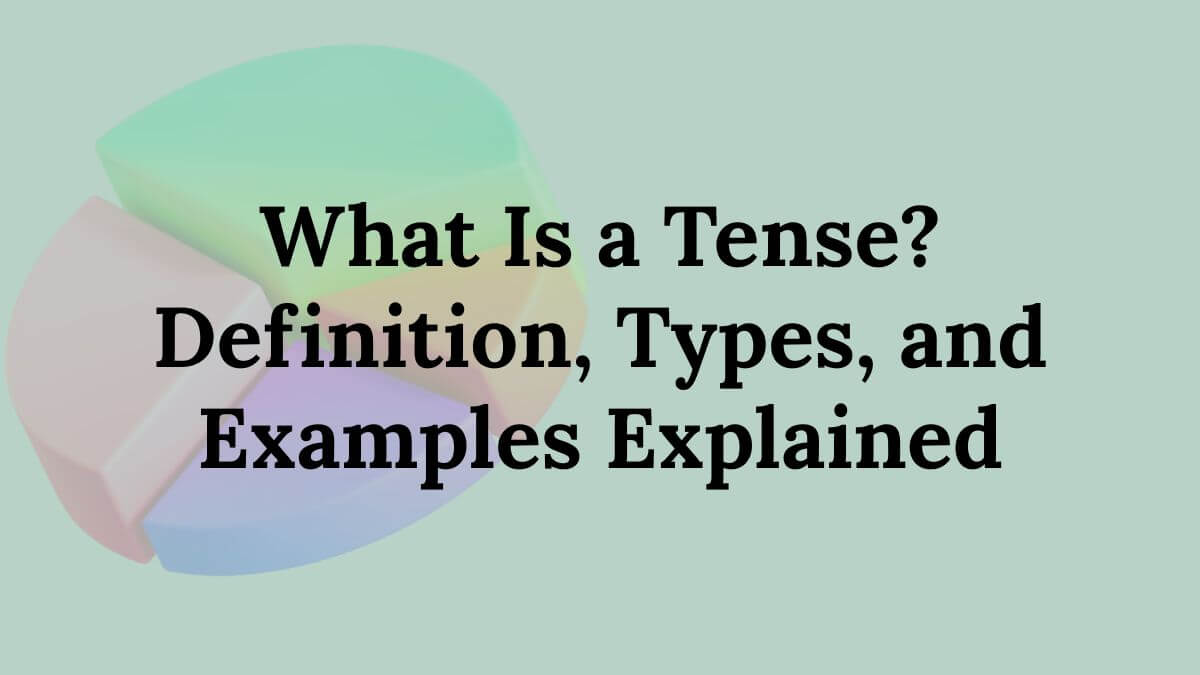What is a tense? Tense in English grammar shows the time of an action. Learn about the types of tenses, definitions, and examples in this easy guide. Understanding what a tense is can unlock the full potential of your English grammar skills.
Whether you’re a student, content creator, or a WordPress web designer building grammar-focused blogs, having a solid grasp of tenses helps you write clearly, professionally, and effectively. In this post, we’ll explore the definition of tense, break down its types, and provide simple examples that will help you use English tenses confidently in everyday communication.
What Is a Tense in English Grammar?
In simple terms, what is a tense? It tells us when an action happens—in the past, present, or future. It’s one of the most essential parts of English grammar because it adds clarity and meaning to your sentences.
The word “tense” comes from the Latin word tempus, which means “time.” In grammar, we use tenses to show the time frame in which an action or event occurs. Every sentence in English must include a verb, and that verb must carry the appropriate tense to make sense.
So, what is a tense in practical use? It’s a tool that helps your reader or listener understand when something happened. Whether you’re writing a blog post, speaking in a meeting, or creating content on your WordPress website, using the correct tense ensures that your message is accurate and clearly understood.
If you’re learning English or creating content about grammar, understanding what a is tense will improve the clarity and impact of your communication. Knowing what is a tense and how to use it correctly is the first step to mastering English grammar.
Why Understanding Tenses in English Is Important
- It helps you express time accurately
- It makes your writing and speech clearer
- It builds confidence in communication
- It is essential for writing professional content (especially useful for bloggers and WordPress creators)
Tenses allow us to narrate stories, plan future events, and describe ongoing actions precisely. Without tenses, English would be confusing and limited.
The Three Main Types of Tenses
In English grammar, understanding what is a tense is crucial to expressing time clearly and correctly. There are three primary tenses that help us communicate when an action happens: Past, Present, and Future. These core tenses are the foundation of how we talk and write about events over time.
To fully grasp what is a tense, it’s important to know that each of these main tenses is further divided into four aspects—Simple, Continuous, Perfect, and Perfect Continuous. This structure results in a total of 12 tenses in English grammar.
Many learners ask, what is a tense and why does it matter? The answer is simple: using the correct tense ensures your message is clear and accurate. Whether you’re speaking, writing, or creating grammar content, understanding what is a tense is the first step toward fluency.
Let’s now explore each type of tense step by step, with clear definitions and examples to guide your learning.
- Present Tense: Actions Happening Now
The present tense is used for actions that are happening right now or facts that are always true.
Types of Present Tense:
- Simple Present: I eat breakfast every morning.
- Present Continuous: She is reading a book.
- Present Perfect: They have finished their work.
- Present Perfect Continuous: He has been studying all night.
- Past Tense: Actions That Already Happened
The past tense shows actions that took place in the past.
Types of Past Tense:
- Simple Past: I visited my friend yesterday.
- Past Continuous: They were watching a movie.
- Past Perfect: She had finished her project before the meeting.
- Past Perfect Continuous: We had been walking for hours.
- Future Tense: Actions That Will Happen
The future tense indicates actions that will occur later.
Types of Future Tense:
- Simple Future: I will call you tomorrow.
- Future Continuous: She will be working late tonight.
- Future Perfect: They will have completed the job by next week.
- Future Perfect Continuous: By noon, he will have been driving for five hours.
Common Mistakes with Tenses in English
Even native speakers sometimes struggle with tenses. Here are a few common errors to avoid:
- Mixing Past and Present in One Sentence
He goes to the store and bought apples.
He went to the store and bought apples.
- Wrong Verb Form
She have gone to school.
She has gone to school.
- Using Present Tense for Completed Actions
I eat dinner already.
I have eaten dinner already.
Helpful Tips to Master Tenses
- Practice daily: Write short sentences in different tenses
- Read English books or blogs: Note how tenses are used
- Use flashcards: Memorize verb forms and structures
- Try grammar tools: Tools like Grammarly or WordPress plugins can correct your tense mistakes
- Create content: If you’re a WordPress designer or blogger, practice using tenses in your posts
Summary Table: 12 Tenses in English Grammar
| Tense Type | Example Sentence |
| Simple Present | She walks to school. |
| Present Continuous | She is walking to school. |
| Present Perfect | She has walked to school. |
| Present Perfect Continuous | She has been walking to school. |
| Simple Past | She walked to school. |
| Past Continuous | She was walking to school. |
| Past Perfect | She had walked to school. |
| Past Perfect Continuous | She had been walking to school. |
| Simple Future | She will walk to school. |
| Future Continuous | She will be walking to school. |
| Future Perfect | She will have walked to school. |
| Future Perfect Continuous | She will have been walking to school. |
Conclusion: Mastering What a Tense Is in English
So, what is a tense, really? It’s far more than just a grammar rule—it’s the foundation that supports every sentence you speak or write. Tenses help us place actions and events in time, allowing our communication to be clear, meaningful, and effective. Whether you’re talking about something that happened yesterday, something happening now, or something that will happen tomorrow, tenses guide your listener or reader through time.
For anyone learning English, understanding what is a tense is a key step toward mastering the language. It ensures you express yourself accurately and confidently in both speech and writing. But knowing what is a tense isn’t only for passing exams—it’s crucial for everyday communication, whether you’re writing content, crafting business emails, posting on social media, or blogging regularly.
If you’re a WordPress web designer, blogger, or content creator, having a clear idea of what is a tense and how to use it properly gives you a professional edge. It improves the quality of your writing, builds trust with your readers, and strengthens your SEO—because search engines love correct grammar. So the next time you write or speak in English, ask yourself: what is a tense, and am I using it correctly?

